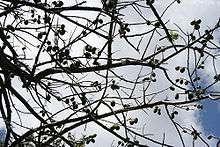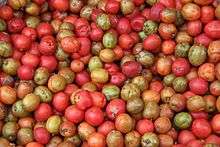Spondias purpurea
| Jocote | |
|---|---|
 | |
| Scientific classification | |
| Kingdom: | Plantae |
| Clade: | Angiosperms |
| Clade: | Eudicots |
| Clade: | Rosids |
| Order: | Sapindales |
| Family: | Anacardiaceae |
| Genus: | Spondias |
| Species: | S. purpurea |
| Binomial name | |
| Spondias purpurea | |
Spondias purpurea is a species in flowering plant in the cashew family, Anacardiaceae, that is native to tropical regions of the Americas and can be found from Mexico to Brasil. It is also very common in most of the Caribbean Islands. It is most commonly known as jocote, which derives from the Nahuatl word xocotl, meaning any kind of sour or acidic fruit.[1] However, this fruit can be particularly sweet when it ripens long enough.[2] Other common names include red mombin, plum, purple mombin,[3] hog plum, ciruela huesito (Venezuela), ciruela, ciriguela, cirigüela,[4] cirguela,[5] and jobito (Ecuador).
Description

_-_Mindanao%2C_Philippines.jpg)
The sap and fruit contain urushiol, an oil that causes an allergic rash upon contact with skin.
In Florida growth is relegated to near-tropical areas of the state, and the tree is killed or greatly harmed by cold winter temperatures from Palm Beach County northward.[6]
The ripe fruit is red and is very sweet to the taste, but it is sometimes eaten unripe with salt and vinegar or lime juice, and is commonly sold in the streets in most Central American countries in plastic bags; also available are red hot pepper sauce and "alhuaishte" (very fine ground toasted pumpkin seeds).
The single large seed, which takes up most of the fruit, is not eaten.
One typical dish in Salvadoran cuisine consists of a syrup made of panela (a molasses made from artisan sugar blocks made by boiling cane juice from a molienda [cane crushing station traditionally ran by oxen or currently with portable gas engines], to evaporate water until it achieves thick molasses consistency, then poured into wood molds and let it cool down. Once solidified later are wrapped in dry corn husk leaves called "tuzas" and sold in the markets. This can be found only during the harvest season, from around Semana Santa (Easter) to the end of August. In Panama and Coastal Ecuador the tree is used throughout the countryside as a living fence and can be propagated by planting trunks.
References
- ↑ Spanish Royal Academy Dictionary
- ↑ "Jocote: beneficios y propiedades del xocote". Natursan. 2012-12-07. Retrieved 2016-06-15.
- ↑ "Spondias purpurea". Natural Resources Conservation Service PLANTS Database. USDA. Retrieved 27 November 2015.
- ↑ Quilis, Antonio; Fresnillo, Celia Casado (2008-01-01). La lengua española en Filipinas: historia, situación actual, el chabacano, antología de textos (in Spanish). Editorial CSIC - CSIC Press. ISBN 9788400086350.
- ↑ "Vicios Del Lenguaje-Rueda Zarate Cruz Valeria 1 j - Documents". documents.mx. Retrieved 2016-06-08.
- ↑ Boning, Charles R. (2006). Florida's Best Fruiting Plants: Native and Exotic Trees, Shrubs, and Vines. Sarasota, Florida: Pineapple Press, Inc. pp. 150–151.
External links
- Miller A, Schaal B (2005). "Domestication of a Mesoamerican cultivated fruit tree, Spondias purpurea". Proc. Natl. Acad. Sci. U.S.A. 102 (36): 12801–6. doi:10.1073/pnas.0505447102. PMC 1200284. PMID 16126899.
- Purple mombin

